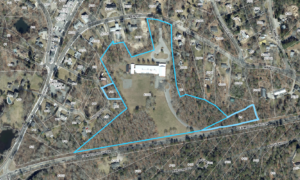 HYANNIS – A Florida man discovered the skills of pioneering interventional radiologist Damian Dupuy, MD, FACR, a little over a decade ago. The man was under hospice care for late stage lung cancer, and contacting Dr. Dupuy, who was practicing in Rhode Island at the time, was his last-ditch effort to improve and extend his life.
HYANNIS – A Florida man discovered the skills of pioneering interventional radiologist Damian Dupuy, MD, FACR, a little over a decade ago. The man was under hospice care for late stage lung cancer, and contacting Dr. Dupuy, who was practicing in Rhode Island at the time, was his last-ditch effort to improve and extend his life.
The man’s hometown oncologist had said his condition was terminal and he therefore could not have any other imaging done to learn more about his lung tumor.
“So he fires his oncologist, calls his son up and says, ‘we have to find a treatment for me,’” said Dr. Dupuy, as he recounted the story. “And his son finds me on the internet and sends me images, and I said, ‘yeah, I can treat that.’
“This guy had one of those big motor homes and he drove up with his wife from Florida. At his first consult, he gave me a copy of his obituary because he thought he would be dead within six months. He ended up living two years after I treated him. He recurred systemically and died of a central tumor.”
Dr. Dupuy is an interventional radiologist who specializes in minimally invasive tumor ablation. He is working in the growing field of interventional oncology, which uses thermal energy to destroy tumors in a minimally invasive way. The procedure is used primarily for lung, kidney, liver, bone and soft tissue, and thyroid cancers.
“We have the ability to basically control where the microwave goes, based on the tip of an antenna that is placed in the human body just like a biopsy needle.” he said. “So we get precision in the millimeters and can sculpt and basically kill tumors in these sensitive locations without damaging collateral structures. And it is all done predominately as an outpatient – with a Band-Aid afterwards.”
Dr. Dupuy perfected the field, known as ‘image-guided tumor ablation,’ at Rhode Island Hospital and Brown University. Working closely with specialists in radiation oncology, medical oncology, pulmonology, thoracic surgery, urology, nephrology, hepatobiliary surgery, colorectal surgery and gynecological surgery, he has treated more than 2,000 patients over the last 20 years.
Non-Surgical Candidates
Image-guided tumor ablation is almost exclusively an outpatient procedure, whereby a needle-like device the diameter of a cocktail straw is inserted through the skin into the tumor using ultrasound or CT scan guidance, explained Dr. Dupuy. With conscious sedation, similar to that used during a colonoscopy, thermal energy in the form of high heat or extreme cold is applied to the local tumor, destroying the cells and a margin of healthy tissue, he added.
“This is not radiation, but thermal energy and it can be repeated as needed,” he said.
Dr. Dupuy’s impact on the field of image-guided tumor ablation is considerable. While practicing at Massachusetts General Hospital in Boston in the early 1990s, he was the first physician in the world to use the early model of this technology to treat a bone tumor. The results were palliative, but “remarkable,” he said.
“This was a patient who had a gastric cancer and it had spread to his pelvic bone and he was having a lot of pain and wasn’t responding to radiation. So we treated him with radiofrequency and we got a great response. It was kind of a ‘eureka!’ moment,” he said.
After that success, he used the technology on liver tumors, and then kidney, lung, adrenal, head and neck, and pelvis.
“Since that time, we have been using needle-like applications, under CT and ultrasound guidance, to treat local tumors for cure and palliative remediation. Currently the most tumors we treat are liver, lung and kidney – and many of them are for a cure. They tend to be patients who are not good candidates for surgery,” he said.
The field of image-guided tumor ablation has advanced over the years to the point where it is becoming the first line in the treatment of liver cancer in patients who have underlying cirrhosis.
“Now we can do a biopsy and an ablation as an outpatient and destroy it completely. We get similar results at a third of the cost,” he said. “People can also return to work and their normal activities within a few days, sometimes the next day.”
If the tumor is large and the treatment is lengthy, patients may experience flu-like symptoms such as fever, fatigue, and lack of appetite, he added. But for the smaller tumors, treatment is quick and there are few after effects, Dr. Dupuy said.
For patients with kidney, liver or lung tumors, image-guided ablation offers promising results.
“Most of the time, I can kill those tumors and keep you from dying from them in a much easier way than traditional therapies,” he said.
With image-guided ablation, the physician deploys the energy through the tip of the device and can verify where it is going by doing an injection of contrast media intravenously wherever the tumor has been treated.
“We can see that as a non-enhancing area because we have killed the blood supply to the tumor,” he said. “We use CT, MRI and PET CT, so we can detect if it’s coming back and if so, where, and we can re-treat it as needed. Unlike radiation where you reach a plateau effect, this is all thermal, so there is no limit to how many times you can repeat it.”
Working With Other Specialists
For certain tumors, like bile duct liver tumors or central lung tumors where there are very large blood vessels adjacent to the tumor, Dr. Dupuy works with other specialists to do other therapies in conjunction with ablation, such as radiation oncology, medical oncology or surgery.
For instance, say there is a tumor the size of a tangerine. Dr. Dupuy would ablate most of the inside of the tumor, leaving the periphery or the ‘peel.’
“Once we heat something and destroy it, the body comes in and tries to heal. It’s like a burn on the skin. The inflammatory cells come into the periphery of the burn zone and that produces blood vessel growth, which increases the oxygen environment around the heated tumor. Radiation only works in a high oxygen environment,” he said. “We can take a large tumor and get much better local control combining the two.”
Dr. Dupuy pioneered this approach while he was at Brown, along with Thomas DiPetrilllo, MD, clinical director of radiation oncology at that time.
At Cape Cod Healthcare, Dr. Dupuy is a member of the multi-disciplinary tumor boards, where cancer cases are discussed and treatment is recommended.
“As a member of that team, my job is to educate and tell people what I can bring to the table,” he said. “Whether or not it’s appropriate depends upon the group decision.”
Image-guided ablation is a growing branch of interventional radiology and thousands of radiologists now specialize in the procedure, according to Dr. Dupuy. He is the only specialist on Cape Cod, and while there are physicians in Boston who perform the specialty, they are concentrating mostly on liver and kidney tumors, he said.
Dr. Dupuy is a strong champion of interventional oncology radiology and image-guided ablation, having seen its evolution and successes over the last 20 years.
“I can diagnose and I can treat. I can read the image and do the biopsy – and kill the tumor – all at the same time.”
Providers who wish to learn more about Dr. Dupuy or who wish to make a referral can call 774-552-6454.























